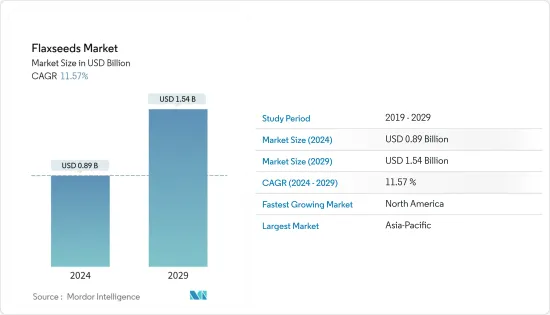
|
市場調査レポート
商品コード
1444126
亜麻仁(フラックスシード):市場シェア分析、業界動向と統計、成長予測(2024-2029年)Flaxseeds - Market Share Analysis, Industry Trends & Statistics, Growth Forecasts (2024 - 2029) |
||||||
カスタマイズ可能
適宜更新あり
|
|||||||
| 亜麻仁(フラックスシード):市場シェア分析、業界動向と統計、成長予測(2024-2029年) |
|
出版日: 2024年02月15日
発行: Mordor Intelligence
ページ情報: 英文 125 Pages
納期: 2~3営業日
|
全表示
- 概要
- 目次
亜麻仁(フラックスシード)市場規模は2024年に8億9,000万米ドルと推定され、2029年までに15億4,000万米ドルに達すると予測されており、予測期間(2024年から2029年)中に11.57%のCAGRで成長します。

主なハイライト
- 亜麻仁またはリンシードは、素晴らしい季節に栽培される一年生の草本作物です。近年、亜麻仁はその素晴らしい健康上の利点と商業的利用により、世界中で人気が高まっています。亜麻仁は、食品や油などの食用目的での使用に加えて、ここ数年繊維産業でも使用されています。世界市場では、亜麻仁は粉砕に使用され、その結果、油と亜麻粕が生産されます。また、全種子、ロースト、発芽、粉砕した種子の形で使用することもできます。
- 亜麻仁油と亜麻仁粉は、人間用および動物用の食品の製造に使用されます。亜麻仁油は、リノリウムの製造、ワニス、インクの製造に業界で広く使用されています。その結果、亜麻の種子は、需要が高く、国内外の市場があるため、世界中のさまざまな気候帯や国で栽培されています。
- カザフスタン、ロシア、カナダ、中国、インド、英国、米国は、世界の亜麻仁生産の主要国です。さらに、亜麻仁は動物飼料や工業目的でチアシードやキノアシードに代わる安価な代替品であり、世界の生産量を増加させています。したがって、健康上の利点による亜麻仁の使用量の増加と世界の生産を促進する工業目的での使用は、今後数年間、亜麻仁市場を推進すると予想される要因の一部です。
亜麻仁市場の動向
スーパーフードの人気の高まりが市場を牽引
消費者が天然で健康的な食材を求める傾向が強まっており、「スーパー」食材の人気がここ数年で大幅に高まっています。これらの製品は、ポリフェノール、抗酸化物質、ビタミン、ミネラルが豊富に含まれているため、優れた栄養価を持っています。亜麻仁には食物繊維、抗酸化物質、タンパク質が豊富に含まれているため、亜麻仁を定期的に摂取すると消化機能が良くなります。
亜麻仁は、世界で最も豊富に知られているオメガ 3の植物源の1つです。たとえば、亜麻仁には天然の油分が40%含まれており、そのうちの55%はオメガ 3エッセンシャルオイルであり、動物と人間の両方に有益であり、代謝プロセス、スタミナ、免疫力などを改善します。さらに、亜麻仁を含む「スーパーフード」の入手可能性の増加により、スーパーマーケット、伝統的な食料品店、コンビニエンスストアでの亜麻仁の需要は、過去数年にわたって途上諸国での亜麻仁の需要を増加させています。
世界中で亜麻仁の需要が高まっているため、世界の亜麻仁の生産量が増加しています。 FAOSTATによると、世界の亜麻仁の収穫面積は、2018年の314万ヘクタールから2021年の414万ヘクタールへと31%以上増加しました。そのため、関連する健康上の利点やスーパーフードとしての利用により、亜麻仁の需要が増加しています。世界の生産量の増加により、今後数年間で亜麻仁市場が牽引されると予想されます。
アジア太平洋が世界の亜麻仁生産をリード
アジア太平洋は世界最大の亜麻仁生産地域です。カザフスタン、中国、インド、オーストラリア、イラクがこの地域の亜麻仁の主要生産国および消費国です。 FAOSTATによると、2020年の収穫面積はカザフスタンだけで134万ヘクタールを超え、総収穫面積の約37%を占めています。世界の亜麻仁の需要の高まりにより、過去数年間でその輸出の可能性が高まっています。
ITC貿易マップによると、カザフスタンの亜麻仁輸出額は2017年から2021年の間に50%以上増加し、2021年には2億2,600万米ドルに達しました。また、アジア太平洋地域は、インドや中国などの人口の多い発展途上国が存在するため、亜麻仁の最大の消費国でもあります。近年の同地域における可処分所得の増加と中産階級世帯の増加により、需要はさらに増加すると予想されています。したがって、アジア太平洋地域における亜麻仁の輸出額、消費量の増加、可処分所得の増加が亜麻仁市場を牽引すると予想されます。
亜麻仁産業の概要
その他の特典
- エクセル形式の市場予測(ME)シート
- 3か月のアナリストサポート
目次
第1章 イントロダクション
- 調査の前提条件と市場の定義
- 調査範囲
第2章 調査手法
第3章 エグゼクティブサマリー
第4章 市場力学
- 市場概要
- 市場促進要因
- 市場抑制要因
- バリューチェーン/サプライチェーン分析
第5章 市場セグメンテーション(生産分析、金額・数量別の消費分析、金額・数量別の輸入分析、金額・数量別の輸出分析、価格傾向分析)
- 地域
- 北米
- 米国
- カナダ
- メキシコ
- 欧州
- ドイツ
- 英国
- フランス
- ロシア
- スペイン
- アジア太平洋
- カザフスタン
- 中国
- 日本
- インド
- 韓国
- 南米
- ブラジル
- アルゼンチン
- 中東とアフリカ
- 南アフリカ
- サウジアラビア
- アラブ首長国連邦
- エジプト
- 北米
第6章 市場機会と将来の動向
The Flaxseeds Market size is estimated at USD 0.89 billion in 2024, and is expected to reach USD 1.54 billion by 2029, growing at a CAGR of 11.57% during the forecast period (2024-2029).

Key Highlights
- Flax seed or linseed is an annual herbaceous crop grown in the excellent season. In recent years, flax seed has gained popularity worldwide due to its fantastic health benefits and commercial usage. Besides its usage for edible purposes such as food and oil, flax seed is also being used in textile industries over the past few years. In the global market, flaxseeds can be used for crushing, which results in oil and flax meal production. It can also be used in the form of whole seeds, roasted, sprouted, and grounded seeds.
- Flaxseed oil and meal are used to produce human and animal food products. Flax oil is widely used in the industry for linoleum production, varnish, and ink production. As a result, Flax seeds are grown worldwide in different climate zones and countries due to their high demand and domestic and international markets.
- Kazakhstan, Russia, Canada, China, India, the United Kingdom, and the United States are some of the leading countries in global flax seed production. Furthermore, flaxseeds are a cheaper alternative to chia seeds and quinoa seeds for animal feed and industrial purposes, increasing global production. Therefore, the increasing usage of flax seeds due to their health benefits and use in industrial purposes driving global production are some of the factors anticipated to drive the flax seed market in coming years.
Flax Seed Market Trends
Growing Popularity of Super Foods is Driving the Market
The popularity of "super" ingredients has increased significantly over the recent past as consumers are more inclined toward natural and wholesome ingredients. These products have superior nutritional value as they are rich sources of polyphenols, antioxidants, vitamins, and minerals. Due to the high dietary fiber content of flax seeds, antioxidants, and protein, regular consumption of flaxseeds helps in good digestive functioning.
Flax seed is one of the world's richest known plant sources of Omega-3. For instance, flax seed naturally contains 40% oil, of which 55% is Omega-3 essential oil that benefits both animals and humans, improving metabolic processes, stamina, immunity, etc. Furthermore, the increased availability of "superfoods," including flaxseeds' in supermarkets, traditional grocery stores, and convenience stores has increased the demand for flax seeds in developing countries over the past few years.
The rising demand for flax seeds worldwide has led to an increase in global flax seed production. According to FAOSTAT, the world harvested area of flax seed has increased by over 31% from 3.14 million hectares in 2018 to 4.14 million hectares in 2021. Therefore, the increasing demand for flax seeds due to associated health benefits and usage as superfoods, along with the increased global production, is anticipated to drive the flax seed market in the coming years.
Asia-Pacific Leads the Global Flaxseed Production
Asia-Pacific is the largest flaxseed-producing region in the world. Kazakhstan, China, India, Australia, and Iraq are the major producers and consumers of flaxseeds in the region. Kazakhstan alone accounts for about 37% of the total harvested area with over 1.34 million hectares in 2020 according to FAOSTAT. The growing global demand for flaxseed has increased its export potential over the past few years.
According to ITC Trade Map, the value of linseed exports of Kazakhstan has increased by over 50% during the period 2017-2021 reaching USD 226 Million in 2021. The Asia-Pacific region is also the largest consumer of flaxseed due to the presence of large populated and developing countries such as India and China. The demand is further anticipated to increase due to the rise in disposable incomes and the growing number of middle-class families in the region in recent years. Therefore, the increasing export value of flax seeds, consumption, and rising disposable incomes in the Asia-Pacific region is expected to drive the flax seed market.
Flax Seed Industry Overview
Additional Benefits:
- The market estimate (ME) sheet in Excel format
- 3 months of analyst support
TABLE OF CONTENTS
1 INTRODUCTION
- 1.1 Study Assumptions and Market Definition
- 1.2 Scope of the Study
2 RESEARCH METHODOLOGY
3 EXECUTIVE SUMMARY
4 MARKET DYNAMICS
- 4.1 Market Overview
- 4.2 Market Drivers
- 4.3 Market Restraints
- 4.4 Value Chain/Supply Chain Analysis
5 MARKET SEGMENTATION (Production Analysis, Consumption Analysis by Value and Volume, Import Analysis by Value and Volume, Export Analysis by Value and Volume, and Price Trend Analysis)
- 5.1 Geography
- 5.1.1 North America
- 5.1.1.1 United States
- 5.1.1.2 Canada
- 5.1.1.3 Mexico
- 5.1.2 Europe
- 5.1.2.1 Germany
- 5.1.2.2 United Kingdom
- 5.1.2.3 France
- 5.1.2.4 Russia
- 5.1.2.5 Spain
- 5.1.3 Asia-Pacific
- 5.1.3.1 Kazakhstan
- 5.1.3.2 China
- 5.1.3.3 Japan
- 5.1.3.4 India
- 5.1.3.5 South Korea
- 5.1.4 South America
- 5.1.4.1 Brazil
- 5.1.4.2 Argentina
- 5.1.5 Middle-East and Africa
- 5.1.5.1 South Africa
- 5.1.5.2 Saudi Arabia
- 5.1.5.3 United Arab Emirates
- 5.1.5.4 Egypt
- 5.1.1 North America


